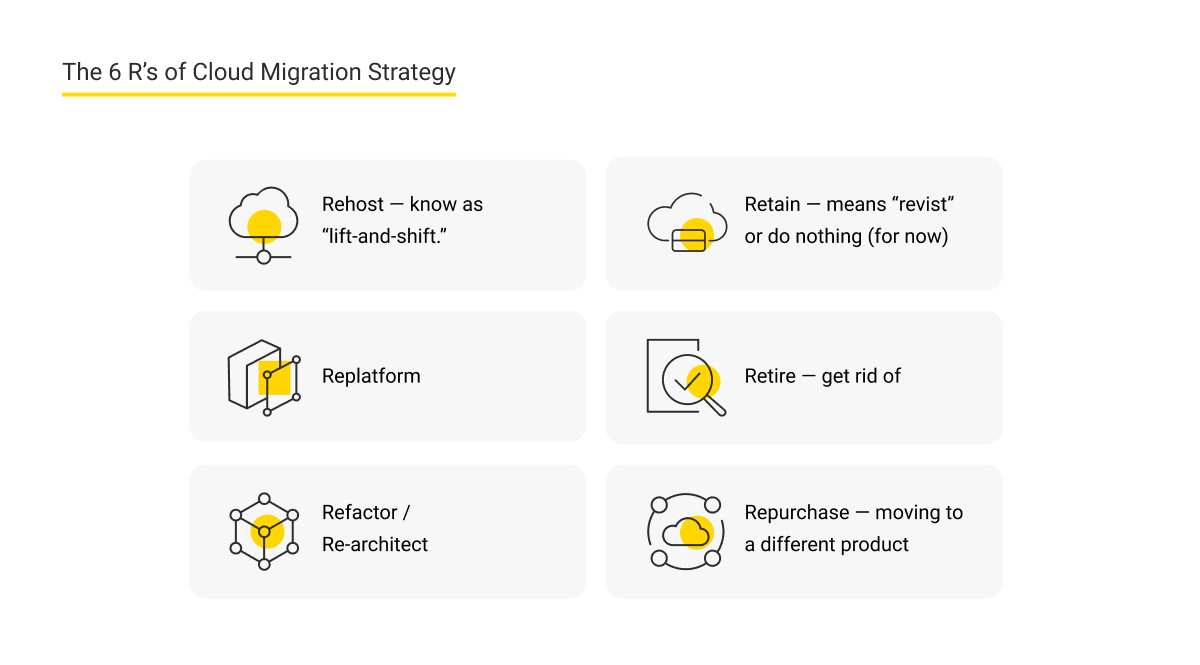- What is cloud migration and why do businesses need it?
- Pitfalls to avoid when performing the transfer
- Lack of strategic planning
- Issues with a provider
- Insufficient protection of user data
- Inadequate security policy support
- Restructuring strategies to choose from
- How to migrate to the cloud step by step
- Cloud migration best practices
- Selecting a reliable IT partner
- Analyzing the current infrastructure
- Training the team
- Aligning the involved parties
- Isolating the migration
- Checking all the requirements
- Optimizing for accuracy
- Performing thorough testing
- Conclusion
Currently, businesses are promptly and efficiently adapting to dynamic market environments by availing themselves of cloud market services. Gartner states that global IT spending on the cloud will account for 14.2% in 2024. In this piece, Andersen provides a full cloud migration overview to make this seemingly complex and convoluted move easy for businesses.
What is cloud migration and why do businesses need it?
The term refers to moving on-premises digital business resources and operations to the cloud. The benefits of migrating to the cloud are clear as such a move allows companies to enhance their productivity in the following ways:
- The increased flexibility of the infrastructure provides for seamless configuration, reconfiguration, and scalability of digital assets;
- Modern equipment with highly reliable monitoring systems significantly increases the stability of operations and reduces business risks;
- Cloud resources ensure the required capacity and increase productivity with no need to rely on underperforming hardware;
- State-of-the-art multi-layered data protection systems ensure improved security of companies’ information;
- Сloud providers’ infrastructure complies with standards and has all the required certifications;
- With no need to invest in equipment and maintain an in-house IT division of high-paid specialists, businesses reduce costs.
Pitfalls to avoid when performing the transfer
For all its strengths, the cloud migration process presents an immense challenge. To safely and successfully undergo it, companies must consider its key pitfalls.
Lack of strategic planning
Companies often underestimate the need to conduct in-depth market investigation and analysis of their infrastructure and goals that will help them to identify the most appropriate transfer scenario. Professional cloud migration consultants will help you deal with the task successfully.
Issues with a provider
There are times when the provider's equipment or virtual infrastructure may fail causing the deletion of data. Choosing a reputable vendor with a proven track record will eliminate this risk.
Insufficient protection of user data
Not all existing network topologies provide effective data protection in a multi-tenant computing environment. This leads to the risk of user data leakage which is considered one of the major risks associated with cloud computing. Therefore, make sure to hire professionals who will build a solid network topology.
Inadequate security policy support
Organizations often don’t have a sufficient number of highly skilled network security professionals to ensure a fully secure reorganization. As a result, critical confidential information can be leaked. The issue is efficiently prevented by augmenting the team with experienced external specialists.
Restructuring strategies to choose from
The choice of the most appropriate cloud migration strategy to adopt should be governed by your objectives and budget. Consider the approaches listed below:
- Retiring, i.e. carefully auditing the company's systems and their dependencies to eliminate outdated apps early in the cloud migration process, thus, saving resources and focusing efforts on software that is crucial for business performance.
- Rehosting, i.e. moving on-premises data and apps to a public cloud which is extremely popular thanks to its straightforwardness and overall simplicity.
- Replatforming, i.e. transferring data while partly tweaking system architecture. The alterations introduced are minor and don’t require rebuilding of the entire system.
- Repurchasing, or 'drop-and-shop', refers to opting for out-of-the-box cloud solutions rather than building custom systems.
- Refactoring means rebuilding software and rewriting some of its code so that it would better suit a cloud platform. Although it’s a tedious process that requires high accuracy, it allows firms to substantially improve their efficiency once implemented.
- Retaining is keeping some of the apps on-premises while moving the rest of them to the cloud.

How to migrate to the cloud step by step
Even though IT architecture differs depending on the type of business, these cloud migration steps are imperative for a smooth transfer:
Devise a plan To start with, inspect the current infrastructure and environment and determine the fundamental assets, taking into account the business objectives and interests of your stakeholders and partners.
Choose the environment Once you have a clear vision of the strategy, make a cloud migration overview to select the right cloud model, e.g. public, private, or hybrid solution.
Migrate apps and data Perform the transfer of your digital assets, ensuring backups and compliance with security policies.
Validate the post-move success After the process is complete, evaluate app performance in a test environment.
Cloud migration best practices
The following pieces of advice will help you conduct the transfer in an efficient and cost-effective manner:
Selecting a reliable IT partner
Finding a dependable vendor is crucial as they will help your business to reach its long-term goals. To make the right pick, you should have a clear understanding of where your company is and where you want it to be. Different providers offer different pricing plans. Andersen’s cloud migration consulting services will help you make the most appropriate choice.
Analyzing the current infrastructure
Carry out a detailed analysis of all the key building blocks of your IT infrastructure to relocate the less critical parts first and the crucial ones only after having established IT support infrastructure.
Training the team
Ensure efficient resource allocation and access control and train your specialists to work in the new environment.
Aligning the involved parties
A lot of problems can arise as a result of insufficient communication between the IT team and the business. Communicate with your partners and other interested parties to ensure a clear understanding of the goals and make them aware of any technical challenges that can impact business operations.
Isolating the migration
It is crucial to ensure the continuity of business operations during data migration. Using intermediate servers will make it possible to continue the work with minimal disruptions.
Checking all the requirements
Consider the entire environment as it functions now and on the target server. Some apps run better on particular servers and configurations that need to be provided for in advance.
Optimizing for accuracy
Most companies expect their operations to run faster after the migration. However, it’s highly recommended to primarily focus on the smooth and accurate work of the new system and to optimize it for speed afterwards.
Performing thorough testing
Test the software end-to-end in the new environment and validate the entire process to be able to rate its success.
Conclusion
Cloud migration is a multi-tiered process that requires a detailed plan for its successful implementation. Its outcome depends on many variables that can all be controlled when turning to cloud migration consulting.
Andersen partners with all the leading providers and ensures that businesses’ infrastructure of any complexity is smoothly reorganized, supported, and maintained. Our seasoned specialists are also in the right position to develop native and hybrid solutions for different industries with a focus on increased revenues and minimized operational costs. If you are considering availing your business of cloud capabilities, feel free to contact us for an informative consultation.





